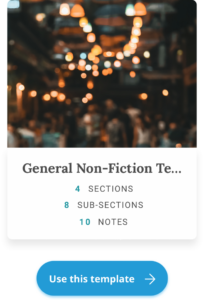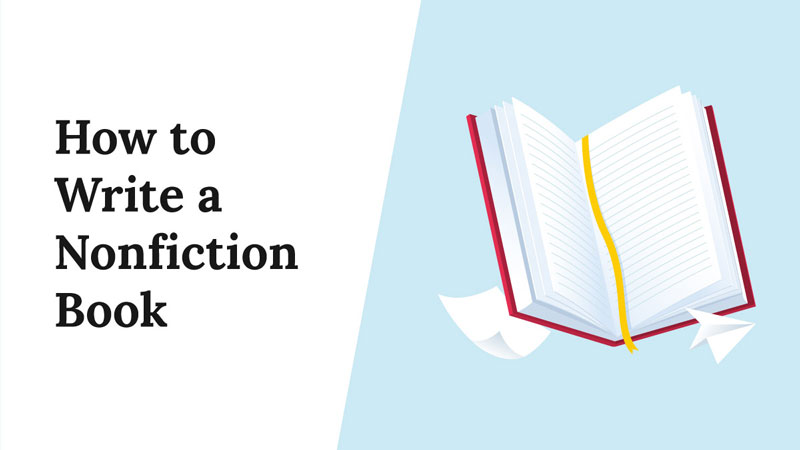This article explores how to write a nonfiction book, a genre encompassing various subjects from history and biography to self-help and science.
Nonfiction writing, distinct from its fictional counterpart, demands a rigorous approach to factual accuracy, comprehensive research, and clarity in presentation. We aim to provide a pragmatic guide for aspiring authors, delineating the steps involved in a nonfiction work’s conceptualization, research, writing, editing, and publishing.
This guide serves both novice and experienced writers, offering insights into each phase of the book-writing process. By adhering to a methodical approach, writers can transform their knowledge and ideas into compelling, well-structured nonfiction books.
How to Write a Nonfiction Book
Here are the main 8 stages of writing a nonfiction book. Let’s start.
Choosing a Topic
Selecting the right topic is the cornerstone of writing a successful nonfiction book. This step is crucial because it influences your writing journey and impacts the appeal to your target audience.
Whether you are writing a nonfiction book for the first time or the tenth time, it never hurts to use a good template. Squibler provides writing-ready templates, including for nonfiction topics.

Identifying Your Passion
Begin by introspecting about subjects you are interested in or even a personal story that you have. The ideal topic should intrigue you and sustain your interest over the long process of writing a book. It could be a field you have expertise in, a hobby you are passionate about, or a subject you have always wanted to explore in depth.
Use Portent’s Content Idea Generator to generate ideas based on any subject you have in mind.
Assessing Market Demand
Once you have a list of potential topics, the next step is to analyze the market demand. This involves researching current trends, finding a popular nonfiction book title in your chosen genre, and identifying gaps in the available literature. Tools like Google Trends and Amazon’s Best Sellers lists can provide insights into what readers are currently interested in.
Conducting Initial Research
Before finalizing your topic, conduct preliminary research to ensure there’s enough information available to cover your subject comprehensively. This research will also help you understand the different perspectives and debates surrounding your topic. It’s important to ensure that the topic is not too broad, making it difficult to cover thoroughly or too narrow, limiting the book’s appeal to a wider audience.
Finalizing Your Topic
After considering your passion, market demand, and the availability of research material, narrow down your choices to one topic. This topic should be interesting and marketable and offer a unique angle or perspective that distinguishes your book from existing works in the field.
Use the Hedgehog Concept to find a great topic for your nonfiction book. Read all about this concept here.

In summary, choosing a topic for your nonfiction book requires balancing personal interest, market viability, and availability of sufficient content. This careful consideration will set the foundation for a compelling and successful nonfiction book.
Research and Gathering Information
Conducting research is a fundamental aspect of writing nonfiction. It involves gathering, organizing, and verifying information to ensure reliability.
Detailed Methods for Conducting Effective Research
Here are helpful methods for conducting research:
- Identify Reliable Sources: Identify authoritative sources such as academic journals, books by respected authors, government publications, and reputable news organizations. Online databases and libraries can be invaluable for this.
- Diverse Research Techniques: Use primary sources (like interviews, surveys, and firsthand observations) and secondary sources (such as books, articles, and documentaries). This mix provides depth and perspective to your research.
- Note-Taking and Documentation: As you gather information, take detailed notes. Record bibliographic information (author, title, publication date, etc.) for each source to make referencing easier later. Tools like Zotero or EndNote can help manage citations.
Tips for Organizing and Compiling Research Materials
Here are some further tips for organizing your nonfiction book writing process.
- Categorize Information: Organize your research into categories related to different aspects of your topic. This will make it easier to find information when you start writing.
- Use Digital Tools: Utilize digital tools such as spreadsheets, document folders, or specialized research software to keep your information organized.
- Maintain a Research Log: Keep a log of your research activities, including where you found information and keywords or topics searched. This log will be invaluable if you need to revisit a source.
By using Squibler for your writing, you can use many tools to organize your writing to stick to a steady schedule.
Ethical Considerations and Fact-Checking in Nonfiction Writing
Here are ethical considerations to be aware of when learning how to write a nonfiction book:
- Fact-Checking: Rigorously check the facts you plan to include in your book. Verify dates, names, quotes, and statistics from multiple sources.
- Avoid Plagiarism: Always give proper credit to the sources of your information. Paraphrase where necessary and use quotations for direct citations.
- Ethical Reporting: Be aware of the ethical implications of your writing, especially when dealing with sensitive topics. Strive for fairness and accuracy in your representation of different viewpoints.
Effective research for a nonfiction book requires a systematic and ethical approach to gathering, organizing, and verifying information. You can ensure that your nonfiction work is credible and compelling by using various research methods, maintaining organized notes, and adhering to ethical standards.
Planning and Outlining the Book
Planning and outlining are critical steps in writing a nonfiction book. This phase involves structuring your ideas and research findings into a coherent and logical framework to guide your writing process.
Importance of Creating a Detailed Outline
Read about the importance of having a detailed outline.
- Blueprint for Your Book: An outline serves as a roadmap for your book, helping you organize your thoughts and research systematically. It ensures that your narrative flows and that you cover all key points.
- Efficiency and Focus: A well-structured outline helps you write. It keeps you focused on your main points and prevents you from veering off-topic.
- Identifying Gaps: During the outlining process, you may identify areas where further research or elaboration is needed, allowing you to address these gaps before you begin writing.
Here is an example of how to outline your book based on the structure:

Methods for Outlining Nonfiction Books
Here, you’ll learn about key methods for creating an outline:
- Chronological Structure: A chronological approach might be most effective for topics that unfold over time, such as historical events or biographies.
- Thematic Structure: If your book covers different aspects of a topic, organizing your outline by themes or subjects can help present information in a more integrated way.
- Problem-Solution Framework: For topics like business or self-help, structuring your outline to present problems and their solutions can engage readers.
Tips for Structuring Your Book
Read some further tips for creating a book structure:
- Start with a Broad Overview: Begin your outline with a broad overview of your topic, then break it into more specific chapters or sections.
- Balance Your Chapters: Try to balance the length and depth of each chapter to keep readers engaged and ensure a smooth flow.
- Include Introduction and Conclusion: Plan for an introductory section to set the context of your book and a conclusion to wrap up and reinforce your key messages.
- Consider Readers’ Needs: Keep your intended audience in mind while outlining. Structure your content to address the readers’ interests, background knowledge, and expectations.

Writing the First Draft
Writing the first draft of a nonfiction book is where you transform your research and outline into a manuscript. This stage is about getting your ideas down on paper and shaping the raw material of your research into a readable and engaging narrative.
Starting the Writing Process
Here, you will read the main steps in writing nonfiction and healthy writing habits for creative nonfiction.
- Overcoming the Blank Page: The first step is to overcome the intimidation of the blank page. Begin by writing about the parts you are most comfortable with or most excited about. This builds momentum.
- Refer to Your Outline: Consult your outline to stay on track. However, be flexible enough to deviate if a section needs more elaboration or a different direction.
- Set Realistic Goals: Establish daily or weekly word count goals. Consistency is key to making steady progress.
- Write Consistent Conversations: A nonfiction writer creates a conversation with their readers. Create a consistent information flow by using one of the four types.
Here are four types of conversations that will give you an idea of what will work best for your audience.

Maintaining a Consistent Writing Routine
Learn how to maintain a writing routine in each writing phase:
- Create a Writing Schedule: Set aside dedicated time for writing each day or week. Consistency is crucial, whether an hour every morning or a full day over the weekend.
- Create a Writing Environment: Find or create a space where you can write without distractions. The right environment can significantly boost your productivity and focus.
Dealing with Writer’s Block
Read about the basics of overcoming writer’s block.
- Take Breaks: Step away from your work if you hit a block. Sometimes, taking a short walk or engaging in a different activity can refresh your mind.
- Write Freely: Don’t be too concerned with perfection in the first draft. Allow yourself to write freely without worrying too much about grammar or style at this stage.
- Talk It Out: Discussing your ideas with someone can provide new perspectives and help overcome blocks.
Staying Motivated
Learn how to stay motivated:
- Track Your Progress: Tracking your progress can be a great motivational tool. Seeing how far you’ve come can encourage you to keep going.
- Seek Feedback: Sharing sections of your draft with trusted friends or other nonfiction authors provides encouragement and constructive feedback.
- Remember Your Purpose: Remind yourself why you started this project. Revisiting your initial inspiration can reignite your enthusiasm.
Writing the first draft of your nonfiction book involves starting with confidence, maintaining a disciplined routine, tackling challenges like writer’s block, and staying motivated throughout the process. This stage is less about perfection and more about bringing your ideas to life in a coherent structure. Remember, the first draft is just the beginning, and refinement comes later in the editing stages.
Editing and Revising
Editing and revising are about refining your first draft and enhancing its clarity, coherence, and overall quality. It involves scrutinizing and improving your manuscript at different levels, from overall structure to individual sentences.
The Importance of a Self-Editing Process
Read about self-editing.
- First Layer of Refinement: Self-editing is your first opportunity to review and improve your work. This process includes reorganizing sections, ensuring each chapter flows logically into the next, and checking for consistency in tone and style.
- Focus on Clarity and Conciseness: Look for areas where arguments can be made clearer, descriptions more vivid, and redundancies eliminated. It’s crucial to be concise and to the point in nonfiction writing.
Seeking Feedback
Here, you will read about basic tips for seeking feedback.
- Beta Readers and Writing Groups: Share your manuscript with trusted individuals representing your target audience. Beta readers or members of writing groups can provide invaluable feedback from a reader’s perspective.
- Constructive Criticism: Be open to constructive criticism. It can provide insights into areas you might have overlooked or not considered fully.
Hiring a Professional Editor
Here’s what to consider if you think you need a professional editor.
- When and Why It’s Necessary: A professional editor can bring a level of polish and expertise that’s hard to achieve on your own. They can help with structural issues, language clarity, and fact-checking. Consider hiring an editor, especially if you plan to self-publish.
- Types of Editing Services: Understand the different editing services available, including developmental editing, copyediting, and proofreading. Each serves a different purpose and is relevant at different stages of the revision process.
Revising Your Manuscript
Here, you’ll read about revising the manuscript.
- Iterative Process: Revision is an iterative process. It may require several rounds to get your manuscript to the desired quality.
- Attention to Detail: Check grammar, punctuation, and factual accuracy. Nonfiction books, in particular, need to be factually correct and well-cited.
- Incorporating Feedback: Integrate the feedback from your beta readers and editor judiciously. Balance maintaining your voice and message with addressing valid concerns and suggestions.
Editing and revising are where your manuscript transforms into its final form. This stage requires patience, attention to detail, and, often, external input. By embracing the editing and revising process, you can significantly enhance the quality of your nonfiction book, making it more engaging, credible, and polished.
Publishing Options
After writing, editing, and revising your nonfiction book, the next critical step in the how-to-write-a-nonfiction-book process is to decide how to publish it. Today, a nonfiction author has various options, each with its own set of advantages and challenges. Understanding these can help you choose the best path for your nonfiction book.
Traditional Publishing
Here, you can read about traditional publishing routes.
- Working with Literary Agents: Traditional publishing typically involves securing a literary agent to represent your book to publishers. An agent’s knowledge of the market and industry contacts can be invaluable.
- The Submission Process: This involves preparing a proposal and sample chapters to send to publishers, often through your agent. The process can be lengthy and competitive.
- Advantages: Traditional publishers offer editorial, design, and marketing support. They can also provide broader distribution channels.
- Considerations: It can be challenging to get accepted by a traditional publisher. They usually control the final product and a significant share of the profits.
Self-Publishing
Here, you can read about the possibility of self-published books.
- Complete Creative Control: Self-publishing gives you total control over every aspect of your book, from the content to the cover design and pricing.
- The Self-Publishing Process: This includes tasks like formatting the book, obtaining an ISBN, and choosing distribution channels (e.g., Amazon’s Kindle Direct Publishing).
- Marketing and Promotion: Self-publishing means you are responsible for marketing and promoting your book. This can be a significant task but also offers the opportunity for higher royalties per book sold.
- Accessibility: Platforms like Amazon, Smashwords, and Draft2Digital have made self-publishing more accessible, offering tools and services to assist authors.
Hybrid Publishing
The third option is hybrid publishing. Read more about it:
- Combination of Traditional and Self-Publishing: Hybrid publishing models combine elements of both traditional and self-publishing, offering more support than self-publishing alone but with more flexibility and control for the author.
- Costs and Services: These publishers often charge for their services, but they also offer professional editing, design, and marketing services.
Choosing the Right Option
Finally, here are tips for deciding exactly what the route to take:
- Consider Your Goals: Consider what you want to achieve with your book. Are you looking to reach a wide audience, maintain creative control, or see your book in bookstores?
- Understand Your Audience: Knowing where your target audience buys books can guide your choice. Some genres do exceptionally well in self-publishing, while others fare better with traditional publishers.
- Assess Your Resources: Consider your budget, available time for marketing, and your comfort level with the various aspects of the publishing process.
The choice between traditional, self-publishing, and hybrid options depends on your goals, resources, and the level of control and support you desire. Each path has its unique set of benefits and challenges, and understanding these can help you make an informed decision about the best way to bring your nonfiction book to your readers.
Marketing and Promotion
The success of a nonfiction book depends on effective marketing and promotion strategies. Here are tactics that you can use:
- Building an Author Platform: A strong author platform is essential for success in marketing. This involves establishing your online and offline presence, which can be achieved through a professional website, active social media profiles, blogging, and networking in relevant communities. An effective platform helps in building credibility and a loyal reader base.
- Effective Marketing Strategies: Developing and implementing a comprehensive marketing plan is key. This could include arranging book launch events, participating in speaking engagements, creating promotional content, and engaging in online marketing efforts. Tailoring these strategies to your target audience and leveraging the right channels are critical for maximum impact.
- Utilizing Social Media: Social media is a powerful tool for promoting your book. Platforms like Twitter, Facebook, Instagram, and LinkedIn offer direct engagement with your audience. Regular posts, interactive content, and targeted ads on these platforms increase your book’s visibility and attract potential readers.
- Book Tours and Speaking Engagements: Conducting book tours and speaking at relevant events can enhance your book’s exposure. These engagements provide opportunities for personal interaction with your audience through physical events or virtual webinars and talks. They are effective in generating interest and boosting sales.
- Engaging with Media and PR: Media engagement is another vital aspect of book promotion. Reaching out to newspapers, magazines, radio, and TV programs related to your book’s topic can help gain wider exposure. Press releases, interviews, and book reviews are traditional yet effective ways to attract media attention.
- Email Marketing: Email marketing involves contacting your audience directly through newsletters and email campaigns. It’s an effective way to keep your readers informed about your book, upcoming events, and any new content you produce.
- Collaborations and Partnerships: Partnering with other authors, bloggers, and organizations can amplify your marketing efforts. These collaborations can include joint promotional events, guest blogging, or featuring on podcasts. Such partnerships can help you reach a broader audience and gain credibility in your field.
FAQs
Here are the most frequently asked questions about how to write a nonfiction book.
1. How do I choose the right topic for my nonfiction book?
Choosing the right topic involves balancing your interests, expertise, and what readers are interested in. Consider topics you are passionate about and know well, then research the market to see if there’s a demand for information on these subjects. It’s also important to ensure there’s enough material available to write a comprehensive book on the topic.
2. How much research should I do for my nonfiction book?
The amount of research needed varies depending on the subject. However, gathering comprehensive and accurate information is vital to establish credibility and trust with your readers. Use a mix of primary and secondary sources and verify facts from multiple sources. Remember, in nonfiction, the quality and reliability of your information are as important as how you present it.
3. Should I write an outline before starting my nonfiction book?
Yes, creating an outline is highly recommended. An outline is a roadmap for your whole book idea, whether you’re writing fiction or nonfiction. It ensures you cover all necessary points and maintain a logical flow throughout the book. Outlines can be modified as you write, but having a basic structure in place can significantly ease the writing process.
4. What are the key steps in editing and revising my nonfiction book?
Editing and revising involves several steps: First, conduct a self-edit to improve structure, clarity, and coherence. Next, get feedback from beta readers or a writing group. Finally, consider hiring a professional editor for developmental editing, copyediting, and proofreading. Pay attention to factual accuracy and consistency, and eliminate redundancies or unclear sections. Remember, editing and revising are crucial for enhancing the quality and readability of your book.












